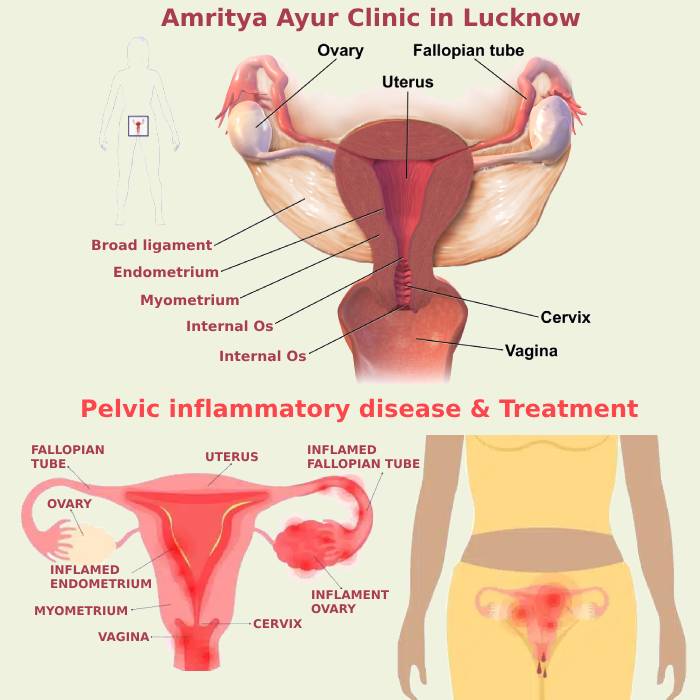Pelvic inflammatory treatment
amrtiyaayuclinic@gmail.com
Dec 27, 2024 08:33 PM
Pelvic Inflammatory Disease (PID) is a serious infection of the female reproductive organs, typically caused by sexually transmitted infections (STIs) like gonorrhea and chlamydia, though it can also result from other infections. Ayurveda, the traditional system of medicine from India, focuses on balancing the body’s energies (Vata, Pitta, and Kapha) to restore health. When treating conditions like PID, Ayurvedic approaches emphasize improving digestion, strengthening the immune system, and using herbs with antimicrobial, anti-inflammatory, and detoxifying properties.
Here are some Ayurvedic treatment approaches for Pelvic Inflammatory Disease (PID):
1. Herbal Remedies
Ayurvedic herbs are commonly used for their antibacterial, anti-inflammatory, and pain-relieving properties. Some of the herbs used for PID include:
- Turmeric (Curcuma longa): Known for its powerful anti-inflammatory and antimicrobial properties, turmeric helps in reducing inflammation and fighting infection.
- Ashwagandha (Withania somnifera): A potent adaptogen that helps in reducing stress and strengthening the immune system. It can be used to support recovery and overall vitality.
- Guduchi (Tinospora cordifolia): Known for its detoxifying and immune-boosting qualities, it can support the body’s natural defenses against infections.
- Neem (Azadirachta indica): Known for its antibacterial, antifungal, and anti-inflammatory properties, neem can help in treating infections and reducing inflammation in the pelvic area.
- Shatavari (Asparagus racemosus): This herb is especially beneficial for women’s health, supporting the reproductive system and helping balance hormones.
- Triphala: A combination of three fruits (Amalaki, Bibhitaki, and Haritaki), Triphala is known for its detoxifying properties, helping to cleanse the body of toxins and support digestion.
2. Panchakarma Detoxification
Panchakarma is a holistic Ayurvedic detoxification therapy that aims to eliminate toxins (called "ama") from the body and restore balance. It includes treatments like:
- Virechana (purgation therapy): This treatment involves the use of herbal laxatives to cleanse the body of toxins and waste.
- Basti (enema therapy): Helps to cleanse the lower digestive tract and balance the Vata dosha, which is believed to be implicated in reproductive system disorders.
- Swedana (steam therapy): This therapy helps to promote circulation, reduce inflammation, and eliminate toxins from the body.
3. Diet and Lifestyle Adjustments
Ayurveda emphasizes the importance of diet and lifestyle to maintain health and treat diseases:
- Anti-inflammatory Diet: Consuming foods that help reduce inflammation and support immunity is crucial. Fresh, organic fruits, vegetables, whole grains, and lean proteins are recommended.
- Avoiding Processed Foods: Foods that are spicy, fried, or highly processed can increase Pitta dosha and exacerbate inflammation, so they should be avoided.
- Hydration: Drinking warm water or herbal teas (such as ginger or cumin tea) helps in detoxifying the body.
- Balanced Routine: Adequate rest, stress management, and a balanced routine help restore the body's equilibrium, improving overall health.
4. Application of Oils
Certain Ayurvedic oils can be used for topical applications to reduce inflammation and improve circulation:
- Bala oil (containing Sida cordifolia) can be massaged onto the lower abdomen to alleviate pain and inflammation.
- Mahanarayan oil is another option used for muscle pain, inflammation, and joint issues.
5. Yoga and Pranayama
Yoga is often recommended in Ayurveda to improve pelvic health, promote circulation, and reduce stress:
- Yoga postures like Supta Baddha Konasana, Setu Bandhasana, and Viparita Karani help strengthen the pelvic floor and improve blood flow to the reproductive organs.
- Pranayama (breathing exercises) like Anulom Vilom and Bhastrika can help calm the mind, reduce stress, and improve oxygen supply to the pelvic organs.
6. Ayurvedic Consultations and Customization
Ayurvedic treatments are highly personalized, based on an individual’s unique constitution (Prakriti), the imbalances in their doshas, and the specific symptoms they are experiencing. Therefore, it’s important to consult a qualified Ayurvedic practitioner who can design a treatment plan specific to the individual’s needs.
Caution and Conventional Care
While Ayurvedic treatments can support healing, PID is a serious condition and can lead to complications like infertility if not treated promptly. It is important to seek medical attention and follow conventional treatments, such as antibiotics, under the supervision of a healthcare provider. Ayurvedic remedies should ideally complement, rather than replace, medical care, especially in acute infections.
In summary, Ayurveda offers a holistic and natural approach to managing PID by using herbs, lifestyle changes, detoxification therapies, and stress management techniques. However, it is crucial to work in conjunction with a healthcare provider to ensure proper diagnosis and treatment.
